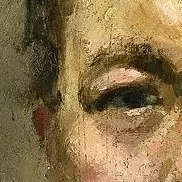Are you an artist? I don’t know many artists with your perspective, but I don’t want to say artists never have this perspective.
As someone with higher education in studio arts, I can’t speak for all artists. But I can say, in my experience, the cognitive skills that allow an artist to break a subject down into base, renderable components aren’t particularly burdened by familiarity. Like, I don’t think it’s harder to realistically paint my face, or my spouse’s face, etc. than it is to paint anyone else’s face. Part of that is just that it’s generally hard to render faces realistically without adding stylistic choices or bridging over the tricky parts, whether the face is familiar or not. Again, just my experience.
I also don’t think realism or “visually accuracy” is necessary for a good self portrait. Sometimes the self portrait is an introspective exercise. Sometimes a self portrait is not representative of our physical self at all, or is fully abstract.
This self portrait is lovely, especially since I feel like (read: don’t know for sure) based on the title that he tried to capture his expressive emotions during a vulnerable moment. It’s raw.








https://youtu.be/11lPhMSulSU